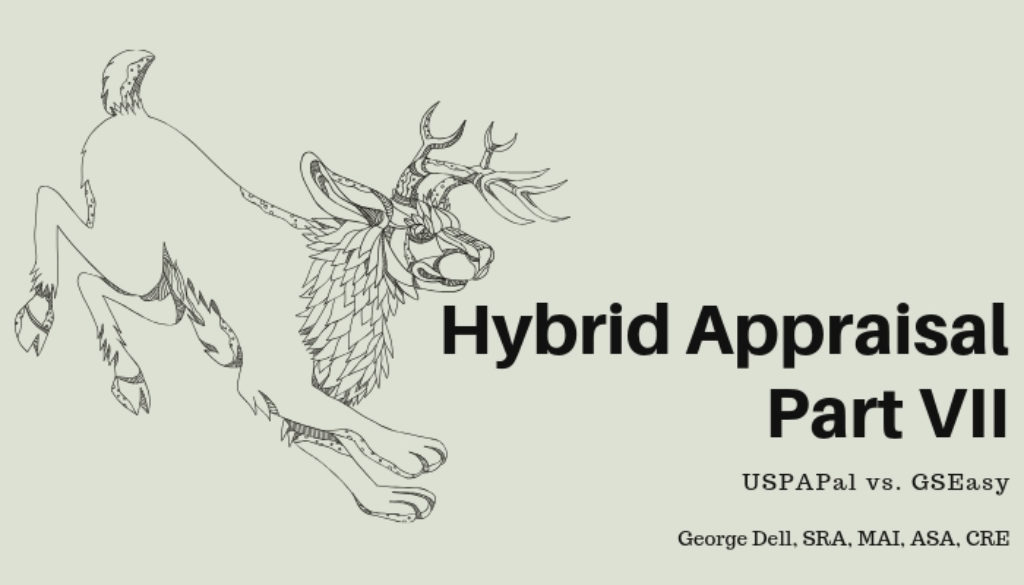Hybrid Appraisal Part VII:
Is it possible that Hybrid appraisals can benefit us all!? Consumer heaven? Taxpayer benefit? Public trust?
Hybrid appraisals are touted as being a “modernization” of the appraisal process. Simply put, a non-appraiser does the inspection of the property, there is no physical assessment of the neighborhood nor any of the comparables. The appraiser suddenly becomes much more efficient, using prior knowledge of the neighborhood, the market segment, and comparable sales. The appraiser fills out the form, selects three or more judgment ‘comparables’, provides E & O insurance, and certifies that all the information is based on reliable sources. Cheaper, faster, and better! What could possibly go wrong?
In this series, we have discussed and continue to discuss other ‘new breed’ issues, such as appropriate scope of work, optimal (HABU) use issues, comparable information field verification, as well as fluffing the USPAP requirement “The appraiser must be prepared to demonstrate that the scope of work is sufficient to produce credible assignment results.” (I guess this means that the appraiser does not need to actually do it, but only be ready to do it if asked). The scope of work includes the extent of: property identification, property inspection, data (comparables?) researched, and analysis applied.
It appears that the client decides on some property identification and inspection level. No physical comparable inspection is done by anyone! The appraiser does get to ‘pick comps’ as always, but no looking is allowed.
Cheaper, faster—accomplished!
How can we do better? Easy. There are only two things left to do: 1) fill out the form; and, 2) pick comps. Well the form really only needs data transferred from the official inspector, public record provider, and the MLS. We already have software that does that. Super.
All we need the appraiser for is the E & O insurance, and the signed certification. This certification certifies that the appraiser has:[1]
- Identified the problem to be solved;
- Determined the scope of work;
- Correctly completed the research and analysis; and,
- Produced a credible appraisal.
Also, relative to the decisions/input of the client and/or inspector– the certifier appraiser certifies that “no one provided significant real property appraisal assistance,” and that he/she
- “accepts full responsibility for all elements of the certification;”
- “is responsible for the decision to rely on [the inspector’s] work;
- “[has] a reasonable basis for believing that those individuals performing the work are competent; and,
- “[has] no reason to doubt that the work of those individuals is credible.
At least one of our GSE (Government Sponsored Enterprises) is testing hybrids, and they are in use under other government exemptions (E. g. evaluations). Go gettem’ – dueling government agencies, quasi-government agencies, and government regulated entities. How fun. No risk. No gamble. No problem.
Consumers will cover the bet and underwrite any inadvertent failures. No problem. We can get there cheaper, faster, and bettor.
[1] Uniform Standards of Professional Appraisal Practice (USPAP) 2020-2021, Standards 1, 3, 7, and 9.
The Appraisal Foundation: (“The nation’s foremost authority on the valuation profession”. . . “Congressionally-authorized.” . . . “ensuring appraisals are independent, consistent, and objective). [Emphases added].

May 15, 2019 @ 3:31 am
The movers and shakers behind Hybrid reports do not have to sign the USPAP Certifications, nor provide Their E&O insurance and license information.
I would be happy to provide the fastest and cheapest reports, just exempt me from USPAP and the contingent liabilities that Certification 23 added when it opened up the stream of commerce to unnamed 3rd parties.
May 15, 2019 @ 9:23 am
All appraisers “Just Say No”
May 17, 2019 @ 8:32 am
They really think an untrained person can correctly measure a complex home to ANSI standards?
May 17, 2019 @ 6:30 pm
Lily, it is all about Their risk management analytics. They think that this hybrid approach will save time and money, more loans can be booked and sold quicker, more bonuses made.
Ever since They figured out that appraisers Hit the Sales Price 98% of the time on the funded loans, They have been on a mission to get rid of their need for them {Us}. Technology, data mining over the last 10 years has created a robust system that can cross check a value estimate. So, why pay full fees to those {Us appraisers} who simply Hit the Sales Price anyway?
Don’t get me wrong, there are appraisers who did not, do not shoot for the sales price, but, rather, measure market value as defined. Those appraisers mostly do not do lender work because it is too low paying and the delivery times are outrageous.
Existing Regulatory Burden on Appraisal, a Proven Failure- System Reform
January 16, 2023 @ 9:46 pm
[…] now, Fannie Mae is intending a ‘bi-furcated‘ valuation, where the licensed/certified appraiser is relieved of the responsibility of […]